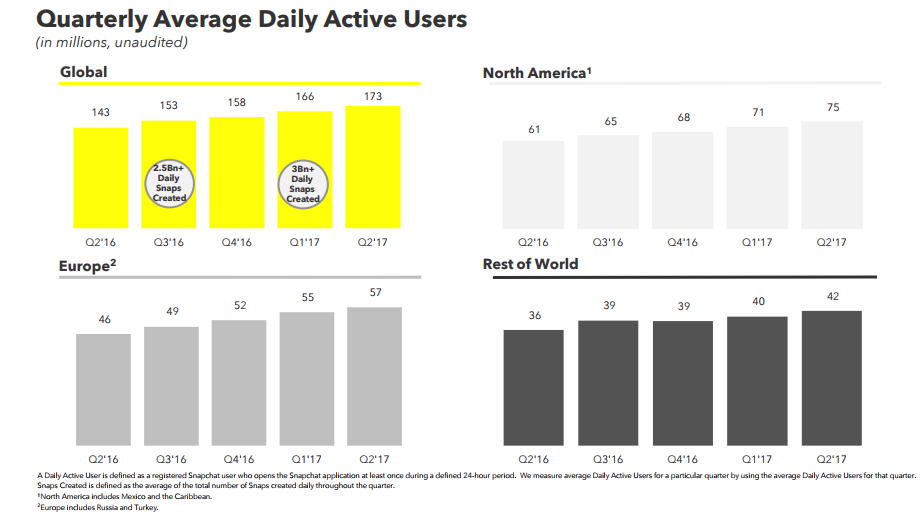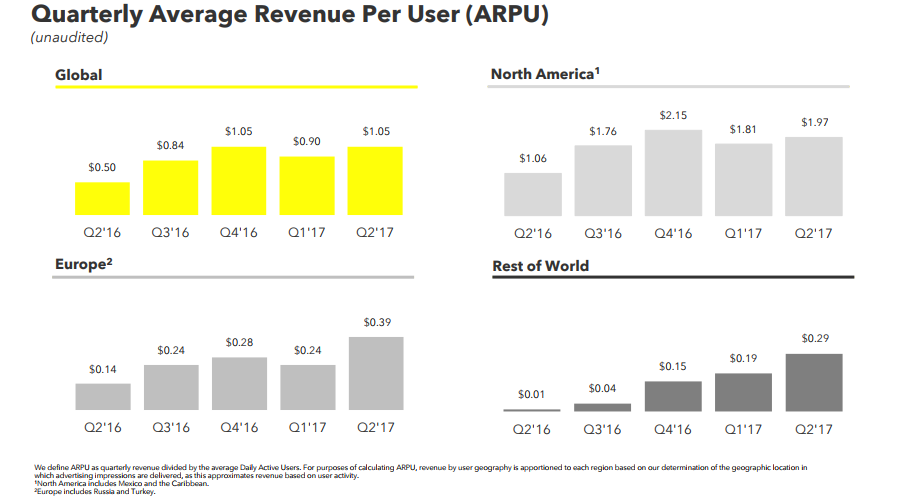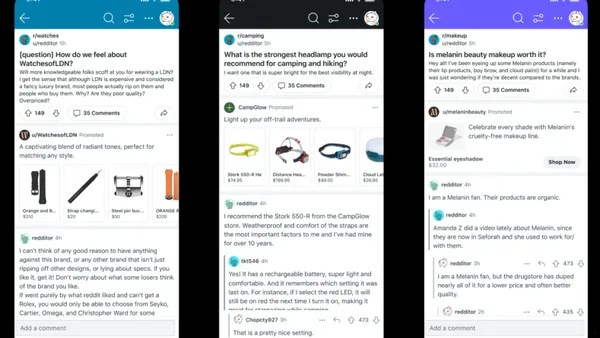Snap Inc., the parent company of Snapchat, has released its Q2 earnings results, and the numbers are pretty much as most expected - i.e. not great.
First off, on user numbers, the key measure the market looks to - for the quarter, Snapchat added seven million more daily active users, taking their total to 173 million DAU.
 For comparison, Facebook added 41 million DAUs in the same period, while Instagram Stories has added 100 million daily users since January. But then again, Twitter added zero, so it's not all bad.
For comparison, Facebook added 41 million DAUs in the same period, while Instagram Stories has added 100 million daily users since January. But then again, Twitter added zero, so it's not all bad.
As you can see from the charts, Snapchat's biggest growth was in its core market in North America, with growth in other regions still not a significant priority. Facebook's been working to limit Snap's capacity in this regard by bringing out Snapchat-like features in international markets, so growth for Snap in these areas will likely always be a challenge.
Market analysts had been hoping to see Snapchat hit 175 million DAU for the quarter, so they haven't hit expectations - and as noted by TechCrunch, Snapchat's user growth rate has slowed from 5% last quarter to 4.2% this time around. Not terrible, but not great, especially at this stage of the app's life cycle. The introduction of Instagram Stories has markedly slowed Snap's momentum.
In terms of revenue, Snap reached $182 million, also missing Wall Street estimates.
 And on one of the key elements, Snap did post an increase in average revenue per user, though only to the same, overall, levels they were in Q4 '16.
And on one of the key elements, Snap did post an increase in average revenue per user, though only to the same, overall, levels they were in Q4 '16.
 Snap has been trying to shift the focus away from raw user numbers and onto engagement - Snapchat users, as Snap notes on their advertiser page, are 'highly engaged', spending more than 30 minutes per day, on average, in the app.
Snap has been trying to shift the focus away from raw user numbers and onto engagement - Snapchat users, as Snap notes on their advertiser page, are 'highly engaged', spending more than 30 minutes per day, on average, in the app.
In order to evade the inevitable Facebook comparison, Snap execs have been using these stats to highlight the stickiness of the app, which, in turn, should theoretically mean greater revenue potential per user. Thus far, that hasn't bore out in the data - but still, an increase in ARPU is positive, just not as positive as some would have hoped.
Also a concern - Snap's operating costs are increasing at a fairly rapid rate, particularly in 'Sales and Marketing'.
 In other words, quarterly revenue increased by $32 million for the quarter, while operating expenses increased by $33 million. Not a great ratio.
In other words, quarterly revenue increased by $32 million for the quarter, while operating expenses increased by $33 million. Not a great ratio.
Shares in Snap Inc. have declined more than 12% following the results.
Snap's been working to boost their revenue potential of late, adding a heap of new tools in just the last quarter, including their self-serve ad platform (which is now available to all businesses), in-app Geofilter creation and purchase, and Snap Publisher, their ad creation tool which simplifies the vertical video composition process, all of which likely haven't had time to impact the revenue stats just yet.
Any new revenue tools are helpful, and these options will definitely provide a range of new opportunities for Snap, broadening the pool of potential ad buyers. But at the same time, they also seem to be pushing the limits. What other ad products can Snap add after this? And will advertisers even care if they can reach a bigger audience elsewhere?
One consideration is the addition of image-recognition-triggered ads, which Snap has actually tested in the live environment - you can even try it out yourself by pointing your Snapchat camera at the Spectacles logo.
Found a cool @Spectacles secret! If you point your Snapchat camera at package's lettering, it gives you a special filter!
- Moshe Isaacian (@MosheIsaacian) November 23, 2016
How it works: pic.twitter.com/wPSVpQjk5T
Snap Inc. actually filed a patent for these types of image-recognition triggered events back in 2015 - as the process is described in the documentation:
"For example, a photograph including an object recognized as a restaurant may result in the user being presented with photo filters that overlay a menu of the restaurant on the photograph. Or a photograph including an object recognized as a food type may result in the user being presented with photo filters that let the user view information e.g., calories, fat content, cost or other information associated with the food type."
More than just informational, the same system could also enable businesses to offer discounts and promotions based on the content of an image - for example, here, a person who's taken a Snap of a cup of coffee is offered a discount coupon based on that snap.
 Various reports have hinted at further development on this front, and at further AR enhancements for Snapchat and Spectacles which could theoretically enable users to overlay real-world scenes with virtual images - and offers. But thus far, nothing has come of it. This may be the best avenue for Snap to take, to push these AR elements to the next level and remain a key innovator.
Various reports have hinted at further development on this front, and at further AR enhancements for Snapchat and Spectacles which could theoretically enable users to overlay real-world scenes with virtual images - and offers. But thus far, nothing has come of it. This may be the best avenue for Snap to take, to push these AR elements to the next level and remain a key innovator.
But the thing is, both Google and Facebook are already looking this way too - here's an example of Google's Lens tool, which they announced at their I/O conference earlier this year.
With Google Lens, your smartphone camera won't just see what you see, but will also understand what you see to help you take action. #io17 pic.twitter.com/viOmWFjqk1
- Google (@Google) May 17, 2017
Looks very similar to Snap's proposed model, right? Facebook's AR Camera tools are moving in a similar direction - even Twitter's looking to implement image-recognition triggered ads.
 What may have seemed like an industry-leading innovation when Snap first started looking at it may be relatively standard by the time they have the technology to support it, which is symptomatic of the company's wider issues.
What may have seemed like an industry-leading innovation when Snap first started looking at it may be relatively standard by the time they have the technology to support it, which is symptomatic of the company's wider issues.
Snap gained a lot of attention very quickly by being a leader in innovation - they popularized disappearing content at just the right time, they pioneered the Stories format, virtual face masks, Geofilters and went to market with a version of smart glasses that people might actually want to wear. But in order to maintain that momentum, and continue the app's growth, they need the next big thing. And now that all the big players are paying attention, their opportunities are becoming more limited.
Really, it seems that Snap may have reached their capacity - the next big step is into that next stage of AR. Where everyone else is also headed. And the prospects of Snap beating out these much bigger players, with more resources and capacity, is not as high as it may have once seemed.
Maybe, Snap's plan was to use the funding from their IPO to take the next step, but given Facebook CEO Mark Zuckerberg believes that we're still five to seven years away from effective AR glasses, it could be that it's not enough.
It is still possible, of course, that Snap could come out with a new version of Spectacles that beats everyone to market (they have a secretive Chinese development lab, so no one knows what they're doing), or new AR tools within their app that beat the tech giants to the punch, using their smaller, more agile approach. But the prospects seems less likely each passing day. And even if they do, it likely won't take long for others to replicate it.
This is the core case for Snap Inc. right now - given their history of innovation, no one's willing to count them out, but increasing competition and slowing user growth are putting the squeeze on the company. And thus far, nothing new is on the horizon. And that's a concern.
Has Snapchat reached its peak? Will they be able to hold onto their audience, and get back to expansion, given Facebook's efforts to restrict their growth?
It would seem that they need something big, something more than a dancing hotdog, to get back to momentum.








